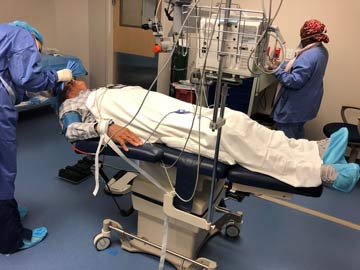April 25, 2024
Growing demand for anesthesia services at ASCs is being met with a dwindling supply of anesthesia providers....
This website uses cookies. to enhance your browsing experience, serve personalized ads or content, and analyze our traffic. By clicking “Accept & Close”, you consent to our use of cookies. Read our Privacy Policy to learn more.
By: Victoria Wiltshire
Published: 6/19/2019
Kids like to drive electric cars to the OR. Older patients prefer the quiet ride of a motorized stretcher chair that transforms from seat to transport stretcher to OR table to recovery recliner as you wheel them from one station to the next.
A strange calm comes over our cataract patients when we tell them that they never have to move from their pre-operative chairs until after they've had their snack and sunglasses. When we show them to their recliner at check-in, they feel like first-class passengers on a 2-hour direct flight to IOL International with no connections or layovers.
Each of our 4 stretcher chairs here at SightTrust Eye Institute Surgery Center in Sunrise, Fla., is a self-contained unit. To the chair's IV poles we strap monitors and baskets that hold the patient's charts. When you can move patients from their pre-op bay to the OR to recovery without transfers and without hooking up and unhooking monitors over and over, you'll save time, reduce the risk of falls and protect your staff from lifting injuries.
It's a stretcher ... It's a table ... It's a recliner ... It's a stretcher chair!
Stretcher chairs are the Swiss Army knives of surgery. With the push of a button on a motorized model with remote-control operation, you can raise, lower and tilt the chair's back, legs and height, taking patients from supine to upright and every sitting and lying position in between, even Trendelenburg. Gone is the need for your surgeons to adjust table height, and for your staff to lift and transfer patients to a different surface. We've programmed our fleet of 4 chairs to the exact height needed, per station, throughout our 2-OR suite: positions for pre-op, transport, surgery and post-op. Staff simply push a button for programmed position 1, 2, 3 or 4, and then hang the remote on a hook on the chair's arm rest.
Staff know which programmable button to hit as they're wheeling patients, and the surgeon knows that patients are right where he needs them to be when he arrives in the laser room.
From a logistical standpoint, stretcher chairs help maximize patient flow and throughput. They're easy to maneuver so you can wheel patients to the ideal locations to perform a task. The inherent limitations of traditional chairs can force you to, let's say, dilate patients in one area and have the surgeon mark patients in a different location.
In the 7-plus years that we've had our stretcher chairs, we've had no mechanical or service repair issues. We paid around $15,000 for each chair, but for a repetitive procedure like cataract surgery, not having to adjust the chair height dozens of times a day saves valuable turnover time, and streamlines the surgical process and patient flow.
To justify the cost, take into account that the stretcher chairs will replace a certain number of stretchers and recliners. You'll also save on nursing time, and experience fewer staff and patient injuries.

Stretcher chairs play a key role in the no-lift/no-transfer work environment we've created for our staff. For starters, they lower your risk of patient falls during transfers. For example, you can lower the height-adjustable chairs enough so patients are able to step out of them instead of having to slide downward off the chair to the floor, and risk a possible trip or fall. Our chairs' slide-back arms and swing-down bed rails allow for easy patient exit from the chair position.
Plus, there is risk of injury to staff every time they have to handle and move a patient. If a patient is uncomfortable and wants to adjust his position in PACU, he can easily do so himself by adjusting a stretcher chair's intuitive controls rather than calling for a nurse or an aide to help. Stretcher chairs are easy to steer and fit into tight spaces — including the restroom, so you won't have to move the patient from a stretcher to a recliner in order for them to use the facilities. Ours come with optional foot-mounted steering handles.
A few tips to get the most out of stretcher chairs:
Programmable, motorized stretcher chairs are the Swiss Army knives of surgery, transforming from seat to stretcher to table to recovery recliner as you wheel patients from pre-op to the OR to PACU.
Staff could struggle shifting from old stretchers to newer stretcher chairs. The chairs are fundamentally different than the stretchers — they don't move the same, sometimes the patients don't look comfortable without the extenders and staff have to learn how to position the patients properly in the chair. But in the end, it's all about making patients feel comfortable and at ease throughout their procedure, and creating a more positive and safer experience for them and your team. OSM
Growing demand for anesthesia services at ASCs is being met with a dwindling supply of anesthesia providers....
Improvements in both workflow and staff attitudes are part of a leader’s responsibilities, but your interventions in these areas don’t need to be major to make...
The ASC market continues its rapid growth. In 2023, roughly 116 new ASCs opened in the U.S., many of which were orthopedic-specific in nature....